|
|
 |




 |
 |
|

|
| |

|
|
| |
Bird´s Nest comes from the saliva of swallows. Basically they are made of the saliva of Apodidae swiftlet and the other swiftlet under the same type. In brief, there are around 90 types of swallows and not all swallow saliva is edible. Those swallows that often bring branches, straw and soil to build nests which are definitely not edible. Edible nests are made of saliva of swiftlet, Feather Prime swiflet or Grass swiflet.
|
|
| |
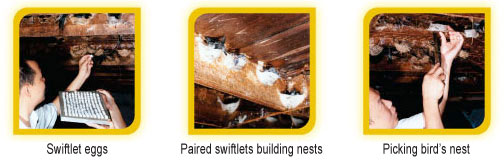
|
|
|
| |

|
|
| |
Origins of bird´s nests are spread in Southeast Asia, including Indonesia, Thailand, Vietnam and Malaysia etc. Different bird´s nests have different textures.
|
|
|
| |
| Indonesia: |
House nest is the most common variety in Indonesia with less
impurities and cleaner. Texture is smoother and softer. Indonesia is the origin
of highest production volume and supplies about 80% of bird´s nest
in Hong Kong.
|
| Thailand: |
Thai bird´s nests are thicker, higher density and firmer in
texture. It takes more time in soaking and stewing. Since production
volume is small, the prices are higher.
|
| Malaysia: |
More Feather Prime swiflet nest products, usually swiftlet processed into cakes and prices are low. Since instant food is usually produced with bird´s nest cakes, there is less and less dry bird´s nest cakes sold on the market and prices are thus increasing.
|
| Vietnam: |
Quality is high with stronger taste and aroma after stewed as compared to others, but supply is very limited.
|
|
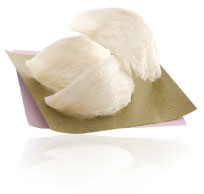 |
|
| |

|
|
| |
Bird´s nests are divided into the two following major categories:
| (1) House Nest: |
Swallow builds nest inside a house called swiftlet. House roof is made of wood. The internal setting of the house imitates the temperature, luminosity and humidity of natural caves. Average temperature is 28°C to 30°C and humidity lies between 89% to 90%, environment is humid and dark. Swallows leave the swiftler house in the morning to look for food outside until evening. Since environment is ideal, there is little impurities and feathers in the bird´s nest and it is cleaner with more complete shape like a boat or a spoon. According to swiftlets´ color they can be divided into white, yellow and red (blood). White nests are softer and smoother while golden nests and red (blood) nests are crispier in texture.
New Knowledge of the Red (Blood) & Yellow Bird´s Nests before purchase
Up to now, there are many controversies over the formation of the Red (Blood) Bird´s Nest. It is believed that the formation of the Red (Blood) Bird´s Nest is because the swallows have consumed several kinds of food. There are different arguments in academia whether this is due to the enzyme of the food, bacteria of the food, chemical reaction or heat in the food. It is also believed that if the swallows´ feces are collected from the swiftlet house and placed next to the bird´s nest for a week (during that the bird´s nest will be stored in plastic container and separated from the swallows´ feces by the gauze) can also formulate the Red´s nest. We have consulted many industry practitioners and believed that over 90% of Red (Blood) Bird´s Nest sold in the market (including us) are formatted based on the latter rationale.
The process of the color formulation of Red (Blood) Bird´s Nest: Bird´s nest will turn white color into yellow color. Then, yellow bird´s nests turn into orange and finally into red (blood bird´s nest). The content of nitrite in yellow bird´s nests will be higher than white bird´s nests, but lower than red (blood) bird´s nests.
Supplementary
After random sampling for the content of nitrite in our red (blood) bird´s nests, the results are shown below:
| HK JEBN
red (blood) bird´s nest |
Dried bird´s nest
2600 ppm |
Rinsed and soaked bird´s nest
88.1 ppm |
Stewed bird´s nest
33.6 ppm |
It shows that after rinsing, soaking and stewing processes, the content of nitrite in bird´s nest drops significantly.
Above result is the average amount based on the testing of the mixture of our few selected piece of red (blood) bird's nest products which are blended together. The content of the nitrite in red (blood) bird's nest of each piece will be varied from 1000ppm to 10000ppm etc.
Acceptable daily intake (ADI) of nitrite is 0.07mg per 1kg body weight. For instance, a 60kg adult will exceed his ADI of nitrite only if one consumes 125g dried red (blood) bird's nests a day. In other words, it means that only if consuming at least 16 pieces of red (blood) bird's nests a day will an adult exceed the standard, assuming the weight of 1 piece equal to 0.2 tael (7.56g).
Since the content of nitrite in bird´s nests is not listed in Hong Kong regulations, we list out the content of nitrite in meat products here for reference.
| Pork and poultry products |
Non-heat treated
200 ppm |
Heat-treated
<125 ppm
(within acceptable range) |
Remarks:
1. Source: Preservatives in Food Regulation (Cap. 132BD), Schedule 1
2. 1 ppm=1/1,000,000; Example:1 ppm means there is 1 mg of nitrite in 1 kg of bird's nests
|
| (2) Cave Nest: |
Swallows build their nests on mountain caves, rock caves and cliffs. Affected by natural climate and environment, the texture tends to be stiffer and harder, with a darker color and less appealing appearance. There are more impurities in cave nest and it takes longer time to soak, giving a crispier texture. |
Varieties
Bird´s nests sold on the market include natural bird´s nest cups, strips, threads, crumbles and scattered pieces processed into cakes of different shapes. There are three major types:
|
|
| |
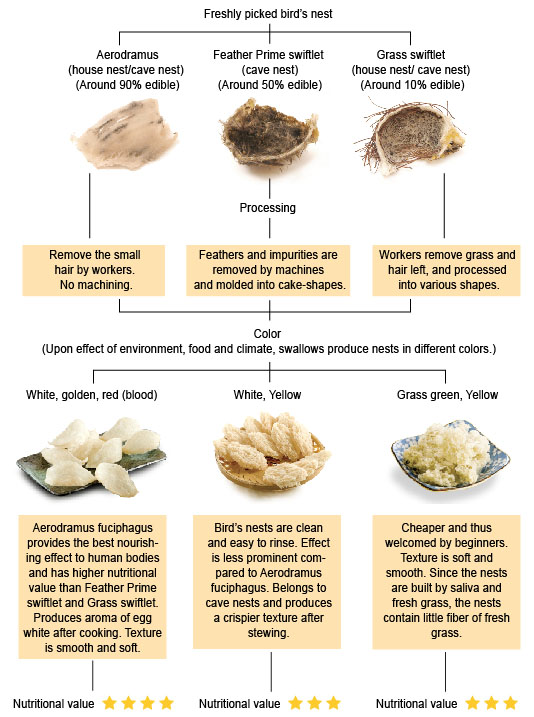 |
|
|
| |

|
|
| |
Usually, the harvesting period of bird´s nest is separated into several months between the harvesting periods. The nests built during the first period, which is from November to March every year, are called the first-tier nests. The second period and third period follow.
| 1st tier: |
With surplus rainfall, reproduction is promoted in small animals. Aerodramus therefore gets sufficient food supply and this strengthens their bodies, thus lead to increase saliva secretion. Impurities are extremely little. The nests are big and thick and volume is the largest when soaked. The 1st tier nests are the most precious.
|
| 2nd tier: |
The second period for building nests. The production sites start entering dry season and the source of food for Aerodramus is reduced. Nests built are looser and the threads are less closely grouped and less dense. The shape and volume after soaking is not as good as the 1st tier.
|
| 3rd tier: |
During the season of extreme dryness, Aerodramus are in their worst body condition. Saliva secretion is slow and feathers fall off quickly, thus impurities (such as feathers) increase. Smaller volume when soaked.
|
|
|
| |

|
|
|
| |

|
|
| |
"Ben Cao Bei Yao (Complete Essentials of the Materia Medica)" composed by Wang Ang in 1694 during the Qing Dynasty and "Ben Jing Feng Yuan
(Origin of Materia Medica)" composed by Zhang Lu in 1695 have
shown that centuries ago, Chinese people have already approved
the effect of bird nests and apply them in disease treatment. From
then on, from 1757 to 1871, a number of scholars and experts have
explained in details in "New Compilation of Materia Medica", "Ben Cao
Qiu Zhen (The truth of Materia Medica)" and "Notes on Compendium of
Materia Medica" the benefits of bird´s nest, proving that it is a previous food with treatment effect. Among them, as in "Notes on Compendium of
Materia Medica", bird´s nest has "sweet taste and is mild and calm in nature, greatly boosts internal fluids and lungs, decreases phlegm and stops coughs, nourishes as well as detoxifies. Sacred medicine for treatment of tiredness and weakness".
|
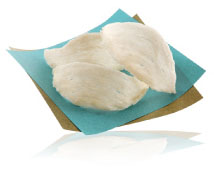 |
|
According to an article entitled "A Study of Bird´s Nest" by Professor Jiang Run Xiang and Mr. Guan Pei Sheng in "Ming Pao Monthly Magazine" (1985, issue 231), after thorough study, it was proved that as early as Ming Dynasty (1536), there were written records about bird´s nest in Huang Zhong's "Hai Yu". In 1596, Tao Ben Jun as described bird´s nest as luxurious food product in "Minzhonghai Cuoshu (the earliest diction on Marine Biology in China)". After over 100 years of consumption and clinical testing, finally a number of scholars have approved the medical treatment effect of bird´s nest and instead of just another kind of food, it was considered as a precious nourishing item.
According to Professor Jiang Run Xiang, references from various times in China have proved that bird´s nest heals the lungs and its effect is extremely prominent on terminal tuberculosis, stomach ulcer and coughing out blood, as well as promoting growth in human body.
In recent years, Professor Jiang has been researching and performing repeated tests on bird´s nest. In experiments on cells in-vitro, bird´s nest is discovered to contain mitogenic stimulation factor and Epidermal Growth Factor to stimulate cell growth and reproduction. It also promotes tissue growth in human beings, cell division and boosts cell immunity. These provide scientific evidence to prove that bird´s nest promotes growth, replenishes energy, speeds up recovery of diseases and improves resistance of body against diseases. The bio-active protein molecules possessed the following three properties:
1. Promotes regeneration of epidermal tissues;
2. Improves immunity of the body generated by cells;
3. Improves resistance of the body against X-rays.
Such bio-active protein molecules are readily absorbed by human bodies and differentiate bird´s nest protein from protein in other foods.
At the same time, the report also showed that the mitogenic stimulation factor in bird´s nests stays active around 80°C, but is lost upon boiling. This explained why bird´s nests need to be stewed over water in low heat.
Bird´s nest can regulate hormones in human bodies, regulate body mechanism, strengthen the body, nourishes and give youthful complexion. It also provides energy to the body and promotes catabolism of fats.
Who should eat bird´s nests?
|
|
|
|
| Type of bird´s nest |
Suitable People |
Functions |
| White |
All. Suitable for all seasons. |
Nourishes and gives youthful complexion.
Regulates body mechanisms. Boosts immunity. |
|
|
|
|
| |

|
|
| |
Per 100g (100g=2.6 tael) |
|
| |
| Ratio |
Nutrients |
| 49.9g |
Multiple proteins |
amide nitrogen
Mono-ammonia-nitrogen
non-ammonia-nitrogen
Arginine
Humin
histidine ammonia-nitrogen
lysine ammonia-nitrogen
cysteine ammonia-nitrogen |
| 30.6g |
Carbohydrates |
hexosamine and similar mucins |
| 4.9g |
Iron |
|
| 2.5g |
Inorganic salts
Also referred to as lime nutrients |
Potassium, Sodium, Calcium, Magnesium, Sulphur,Phosphorous, Silica and other micronutrients |
| 1.4g |
dietary fibre |
|
| 10.7g |
others |
|
|
|
| |
Source: Dictionary of Traditional Chinese Medicine, Xin Lin Shi Hua (Historical notes on medicine) and
Food ingredients chart.
|
|
|
| |

|
According to recommendations of registered nutrition therapists, to cope with human body's ability to absorb pro-active protein molecules, regular doses should be taken continuously. Here are two serving methods for better results:
(1) 1 to 2 bowls per week
(2) 1 to 2 tablespoons per day
|
|
|
|

| |

|
|
| |
(1) Size and volume
The most popular shapes are boat or spoon shape. If swallows build their nests on the corner of two walls, the shape of nest will become triangular. There is no effect on the nutrition value. Wider bird´s nests cups have higher quality. Natural bird´s nests cups are genuine bird´s nests.
(2) Color and purity
In natural color, without any soil, sand or moss is the best quality of bird´s nests. White bird´s nests are in color of slight "ivory". Yellow bird´s nests are in color of slight "beige" or "golden". Red (blood) bird´s nests are in red. All the bird´s nests will rehydrate and turn into lighter color after soaking in water, the thread of bird´s nests will become transparent. The water after soaking bird´s nests normally remains clear. However, the water after soaking red (blood) bird´s nests will become a little bit yellow. If the bird´s nest is extremely white, which means it may have been bleached, this will greatly reduce the nutrition content and harm the health.
(3) Density and volume after soaking
If threads are thinner and closer, gaps are few and size is large and thicker, bird´s nest cups will expand more after soaking. Bird´s nest of different grade has different expansion ratios. The weight after soaking is several times of that before soaking. The "degree of expansion" refers to the degree of water absorption. A larger degree means greater expansion and volume.
(4) Taste and humidity
Differentiate bird´s nests with your nose, there should be a smell of swallow's saliva and stink of blood, and slight aroma of egg white after being cooked. Dry bird nests should be choosen. If they are sticky or soft, the moisture content is high, storage is difficult and mould grows easily.
(5) Price and trustworthiness
You must "see, smell and touch" the bird´s nests to choose good ones. Price of bird´s nests are judged by their taste, size, thickness, dryness and density. If you do not take a look at the goods, consider grades and quality, but only look at the names and prices as set by the company, it is impossible to pick cheap and nice goods. The best choice is to purchase from trustworthy shops with quality assurance.
|
|
|
| |

|
|
| |
Only natural bird´s nests are genuine bird´s nests. There are illegal acts of painting the nests with egg white or jelly to increase weight. Such bird´s nest will be opaque when placing under spotlight. Genuine bird´s nest shall be translucent. As for someone use "gutta-percha" or "pig's skin" as counterfeit goods, those made of gutta-percha give sour taste and do not appear as threads; those made of pig's skin will produce oil and milky appearance in water when soaked.
To differentiate between good grades and bad grades, in general bird´s nests of better quality and higher grades are of higher nutritional value and greater expansion degree. The outlook is also neater. Those of lower quality are of lower nutritional value and less expansion degree. Outlook is also inferior.
|
|
| |
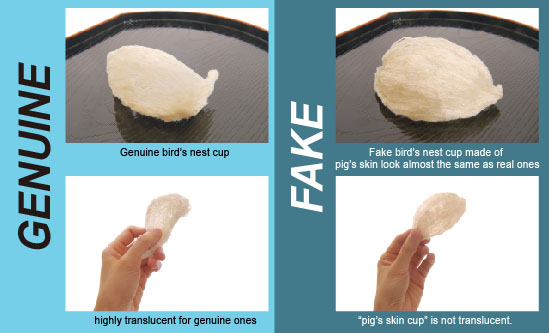 |
|
|
| |

|
|
| |
| (1) |
First, the bird´s nest must be soaked in clean water and during the process; water should be refreshed for once or twice. Do not keep water that has been used (since different types of bird´s nest require different soaking time, time on the package should be strictly followed).
|
| (2) |
When bird´s nests are soaked, small hair should be removed by stainless forceps (natural bird´s nest contain minute amount of hair and this is totally normal. Elderly or people with inferior eye sight should place a piece of white cloth on palm to reduce tiredness.)
|
| (3) |
Place soaked bird´s nest in double-layered stainless steel filter. Rinse with running water and tear off the nest to remove impurities. |
|
|
| |
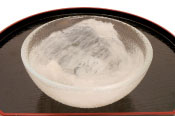 |
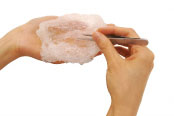 |
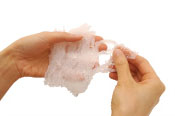 |
| soak |
hair removal |
tear off |
|
|
|
| |

|
|
| |
To stew bird´s nest, you need a stewing bowl and a pot that can place the entire bowl (ceramic pot or stainless steel pot are fine). Place the soaked and cleaned bird´s nest into the stewing bowl, add suitable amount of hot water (around 80°C), cover well and place the entire stewing bowl into the pot. Pour boiling water to half of the height of the stewing bowl and simmer.
Water level in the stewing bowl
The level of other ingredients and boiled water (or other nutrients) added to the stewing bowl shall not exceed 70% of the stewing bowl. This is because during the process of stewing, all ingredients being heated will expand and increase the water level. If the water level before heating is too high, it may lead to overflow and wastage. |
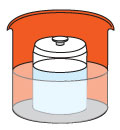 |
|
Control the degree of heating
The mitogenic stimulation factor in bird´s nests stays active around 80°C, thus boiling would lead to reduced effect. Bird´s nests should stewing over water in low heat. This keeps the temperature around 80°C and thus prevent damaging proteins in the bird´s nest and reserve the aroma and nutrients. Thus, when stewing bird´s nest, hot water should be used both inside and outside the stewing bowl and it should be stewed. If time is not allowed, it is the safest and most convenient way to use electronic stewing pot and set it to low stewing. |
|
|
| |

|
Since bird´s nests are from various countries of origin, species, expansion ratio and treatment effect, plus different grades, pricing and textures, customers can consider the above factors and pick suitable products according to one's own needs. Also, when you prepare bird´s nest on your own, it is pure and hygienic with no additives and preservatives, 100% genuine and cost-effective. Prepare your own instant bird´s nest soup and have it sweet, salty, hot or cold, whichever you like.
There are different methods to serve bird´s nest. Stew the bird´s nest in advance and you can easily prepare different cuisine with it. The steps are pretty easy – only 3 of them:
| 1. |
Soak the bird´s nest thoroughly*, rinse them clean and leave dry.
|
| 2. |
Put bird nest into the stewing bowl and pour hot water until it covers the entire bird´s nest. Cover the stewing bowl and stew over hot water for 30 minutes. This is your instant bird´s nest (Do not add any flavorings. Add them when served.)
|
| 3. |
When the bird´s nest cools down, wrap it with plastic wrappers and store in refrigerator. Freshly prepared stewed bird´s nest can be kept for 1 week at most. |
*Please follow the soaking and stewing time as stated on the package.
To prepare your own Rock Sugar Syrup
Put rock sugar in the pot and add equivalent amount of hot water. Stir from time to time with chopsticks and slowly stew until all sugar has melted in the water. When it cooled down, pour it into a bottle and close the lid. Place in refrigerator. Add according to one's own preference to stewed bird´s nest when served.
Tips:
| 1. |
The rock sugar is formed by allowing a supersaturated solution of white sugar and water to crystallize, thus producing crystals of higher purity and hygiene level. According to Chinese medicine practitioners, rock sugar replenishes and enriches vital energy and caters the stomach and lungs. Brown sugar, on the other hand, is not clear and easily induces heat. White sugar arouses phlegm. Thus, when stewing nourishing food items such as bird´s nest, the best choice would be rock sugar.
|
| 2. |
Use a clean spoon every time when eating to ensure hygiene. When served hot, make sure you reheat the instant bird´s nest before you add the rock sugar syrup. Do not reheat by microwave, since the extremely high temperature would cause nutrients in bird´s nest to lose.
|
|
|
|
|
| |

|
Sweetness mainly belongs to Spleen Meridan and is mild in nature. It is neither hot nor cold and provides comforting and nourishing effect. Eating appropriate amount of sweet food would regulate body properties. Bird´s nest tastes better when served sweet.
Salty way of serving usually means adding salt. Salt is cold in nature, salty in taste and functions to remove heat from body, cool down the blood and detoxify. Salty taste belongs to Kidney Meridan. Eating appropriate amount of salty food would nourish the kidneys and this is especially suitable for diabetic patients.
Hot means warmth and is Yang in nature. It is active, flowing and open. If one normally shows symptoms of coldness, one shall have the bird´s nest served hot.
Cold means coldness and is Yin in nature. It is stationary and closed. If one normally shows hot and heaty symptoms, one shall have the bird´s nest served cold.
This is why you need to pick a way of serving according to your body's nature: sweet, salty, hot or cold.
If the bird´s nest is served sweet, only add the rock sugar 15 minutes before stewing completed so as to keep the bird´s nest as it is. When served salty, only add salt before serving. If you add salt when stewing starts, salt will disintegrate the bird´s nest, make it shrink and turn it crispy.
|
|
|
|
| |

|
Bird´s nest is the precious saliva secreted by swallows. Just as for other food, it has to be properly stored. The ideal way is to place it in a completely sealed box and in the refrigerator. Ask our shop staff for details. If the bird´s nest absorbs moisture, you can place it in front of the air conditioner and blow dry. Do not put it in the oven or place it under the sun for drying.
|
|
|
|
*The products in this website are health supplyment only. If there are any questions, please refer to your Chinese medicine doctors or professionals.
|
| |
|
|









